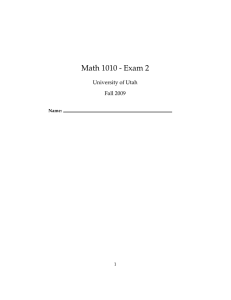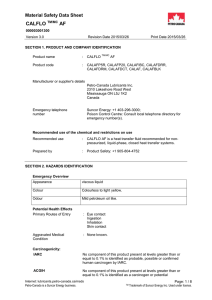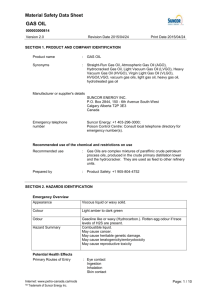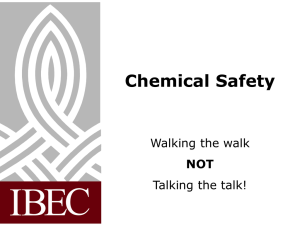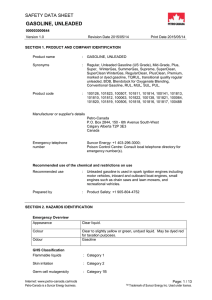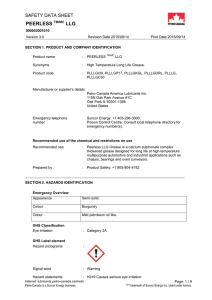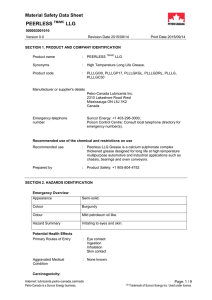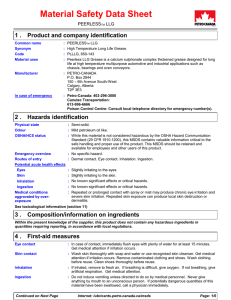2898 GASOLINE, UNLEADED (English (GB)) PC MSDS NA 4.0.5
advertisement
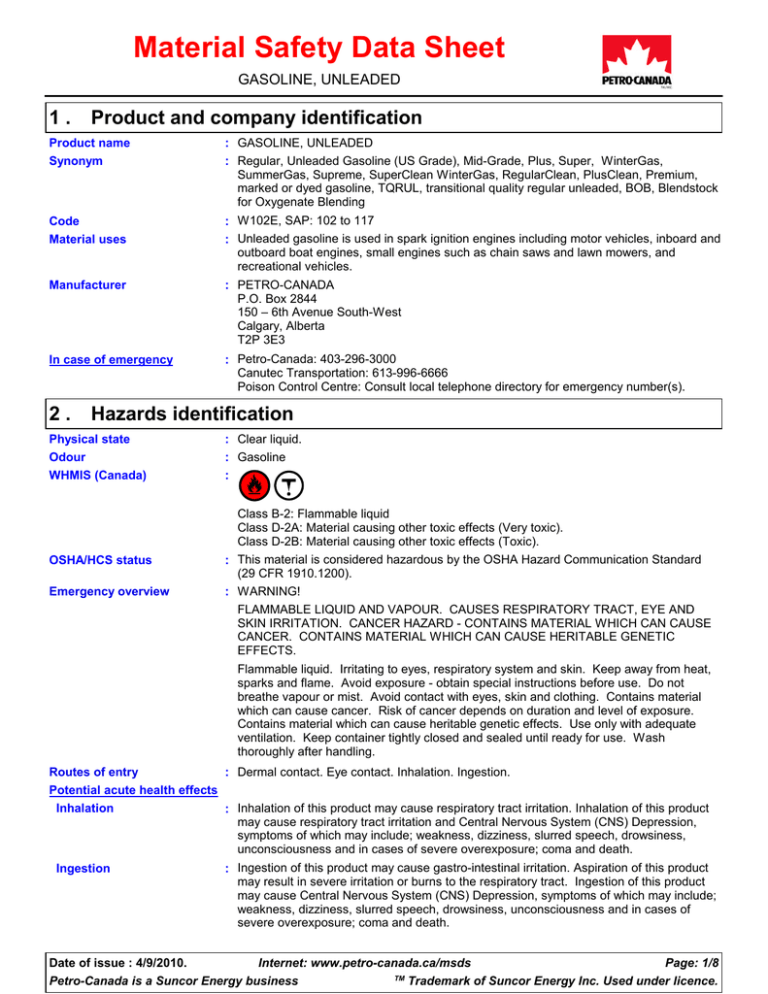
Material Safety Data Sheet GASOLINE, UNLEADED 1. Product and company identification Product name Synonym : GASOLINE, UNLEADED : Regular, Unleaded Gasoline (US Grade), Mid-Grade, Plus, Super, WinterGas, SummerGas, Supreme, SuperClean WinterGas, RegularClean, PlusClean, Premium, marked or dyed gasoline, TQRUL, transitional quality regular unleaded, BOB, Blendstock for Oxygenate Blending Code Material uses : W102E, SAP: 102 to 117 : Unleaded gasoline is used in spark ignition engines including motor vehicles, inboard and outboard boat engines, small engines such as chain saws and lawn mowers, and recreational vehicles. Manufacturer : PETRO-CANADA P.O. Box 2844 150 –6th Avenue South-West Calgary, Alberta T2P 3E3 In case of emergency : Petro-Canada: 403-296-3000 Canutec Transportation: 613-996-6666 Poison Control Centre: Consult local telephone directory for emergency number(s). 2. Hazards identification Physical state Odour WHMIS (Canada) : Clear liquid. : Gasoline : Class B-2: Flammable liquid Class D-2A: Material causing other toxic effects (Very toxic). Class D-2B: Material causing other toxic effects (Toxic). OSHA/HCS status Emergency overview : This material is considered hazardous by the OSHA Hazard Communication Standard (29 CFR 1910.1200). : WARNING! FLAMMABLE LIQUID AND VAPOUR. CAUSES RESPIRATORY TRACT, EYE AND SKIN IRRITATION. CANCER HAZARD - CONTAINS MATERIAL WHICH CAN CAUSE CANCER. CONTAINS MATERIAL WHICH CAN CAUSE HERITABLE GENETIC EFFECTS. Flammable liquid. Irritating to eyes, respiratory system and skin. Keep away from heat, sparks and flame. Avoid exposure - obtain special instructions before use. Do not breathe vapour or mist. Avoid contact with eyes, skin and clothing. Contains material which can cause cancer. Risk of cancer depends on duration and level of exposure. Contains material which can cause heritable genetic effects. Use only with adequate ventilation. Keep container tightly closed and sealed until ready for use. Wash thoroughly after handling. Routes of entry : Dermal contact. Eye contact. Inhalation. Ingestion. Potential acute health effects Inhalation : Inhalation of this product may cause respiratory tract irritation. Inhalation of this product may cause respiratory tract irritation and Central Nervous System (CNS) Depression, symptoms of which may include; weakness, dizziness, slurred speech, drowsiness, unconsciousness and in cases of severe overexposure; coma and death. Ingestion : Ingestion of this product may cause gastro-intestinal irritation. Aspiration of this product may result in severe irritation or burns to the respiratory tract. Ingestion of this product may cause Central Nervous System (CNS) Depression, symptoms of which may include; weakness, dizziness, slurred speech, drowsiness, unconsciousness and in cases of severe overexposure; coma and death. Internet: www.petro-canada.ca/msds Page: 1/8 Date of issue : 4/9/2010. TM Petro-Canada is a Suncor Energy business Trademark of Suncor Energy Inc. Used under licence. GASOLINE, UNLEADED 2. Page Number: 2 Hazards identification Skin : Irritating to skin. Eyes : Irritating to eyes. Potential chronic health effects Chronic effects : This product contains an ingredient or ingredients, which have been shown to cause chronic toxic effects. Repeated or prolonged exposure to the substance can produce blood disorders. Carcinogenicity Mutagenicity Teratogenicity Developmental effects Fertility effects Medical conditions aggravated by overexposure : Contains material which can cause cancer. Risk of cancer depends on duration and level of exposure. : Contains material which can cause heritable genetic effects. : No known significant effects or critical hazards. : No known significant effects or critical hazards. : No known significant effects or critical hazards. : Repeated or prolonged contact with spray or mist may produce chronic eye irritation and severe skin irritation. Repeated skin exposure can produce local skin destruction or dermatitis. See toxicological information (section 11) 3. Composition/information on ingredients Name Gasoline Ethanol Benzene Toluene *Montreal: may vary from 3-40% *Edmonton: may vary from 1-5% CAS number 86290-81-5 64-17-5 71-43-2 108-88-3 % 85-100 0.1-1 0.5-1.5 15-40* There are no additional ingredients present which, within the current knowledge of the supplier and in the concentrations applicable, are classified as hazardous to health or the environment and hence require reporting in this section. 4. First-aid measures Eye contact : Check for and remove any contact lenses. Immediately flush eyes with plenty of water for at least 15 minutes, occasionally lifting the upper and lower eyelids. Get medical attention immediately. Skin contact : In case of contact, immediately flush skin with plenty of water for at least 15 minutes while removing contaminated clothing and shoes. Wash skin thoroughly with soap and water or use recognised skin cleanser. Wash clothing before reuse. Clean shoes thoroughly before reuse. Get medical attention immediately. Inhalation : Move exposed person to fresh air. If not breathing, if breathing is irregular or if respiratory arrest occurs, provide artificial respiration or oxygen by trained personnel. Loosen tight clothing such as a collar, tie, belt or waistband. Get medical attention immediately. Ingestion : Wash out mouth with water. Do not induce vomiting unless directed to do so by medical personnel. Never give anything by mouth to an unconscious person. Get medical attention immediately. Protection of first-aiders : No action shall be taken involving any personal risk or without suitable training. If it is suspected that fumes are still present, the rescuer should wear an appropriate mask or self-contained breathing apparatus. It may be dangerous to the person providing aid to give mouth-to-mouth resuscitation. Wash contaminated clothing thoroughly with water before removing it, or wear gloves. Notes to physician : No specific treatment. Treat symptomatically. Contact poison treatment specialist immediately if large quantities have been ingested or inhaled. Internet: www.petro-canada.ca/msds Page: 2/8 Date of issue : 4/9/2010. TM Petro-Canada is a Suncor Energy business Trademark of Suncor Energy Inc. Used under licence. GASOLINE, UNLEADED 5. Page Number: 3 Fire-fighting measures Flammability of the product Extinguishing media Suitable Not suitable Special exposure hazards : Flammable liquid (NFPA) . Products of combustion : Carbon oxides (CO, CO2), nitrogen oxides (NOx), polynuclear aromatic hydrocarbons, phenols, aldehydes, ketones, smoke and irritating vapours as products of incomplete combustion. Special protective equipment for fire-fighters : Fire-fighters should wear appropriate protective equipment and self-contained breathing apparatus (SCBA) with a full face-piece operated in positive pressure mode. Special remarks on fire hazards : Extremely flammable in presence of open flames, sparks, shocks, and heat. Vapours are heavier than air and may travel considerable distance to sources of ignition and flash back. Rapid escape of vapour may generate static charge causing ignition. May accumulate in confined spaces. Special remarks on explosion hazards : Do not pressurise, cut, weld, braze, solder, drill, grind or expose containers to heat or sources of ignition. Containers may explode in heat of fire. Vapours may form explosive mixtures with air. 6. : Use dry chemical, CO2, water spray (fog) or foam. : Do not use water jet. : Promptly isolate the scene by removing all persons from the vicinity of the incident if there is a fire. No action shall be taken involving any personal risk or without suitable training. Move containers from fire area if this can be done without risk. Use water spray to keep fire-exposed containers cool. Accidental release measures Personal precautions : No action shall be taken involving any personal risk or without suitable training. Evacuate surrounding areas. Keep unnecessary and unprotected personnel from entering. Do not touch or walk through spilt material. Shut off all ignition sources. No flares, smoking or flames in hazard area. Avoid breathing vapour or mist. Provide adequate ventilation. Wear appropriate respirator when ventilation is inadequate. Put on appropriate personal protective equipment (see section 8). Environmental precautions : Avoid dispersal of spilt material and runoff and contact with soil, waterways, drains and sewers. Inform the relevant authorities if the product has caused environmental pollution (sewers, waterways, soil or air). Methods for cleaning up Small spill : Stop leak if without risk. Move containers from spill area. Dilute with water and mop up if water-soluble or absorb with an inert dry material and place in an appropriate waste disposal container. Use spark-proof tools and explosion-proof equipment. Dispose of via a licensed waste disposal contractor. Large spill : Stop leak if without risk. Move containers from spill area. Approach the release from upwind. Prevent entry into sewers, water courses, basements or confined areas. Wash spillages into an effluent treatment plant or proceed as follows. Contain and collect spillage with non-combustible, absorbent material e.g. sand, earth, vermiculite or diatomaceous earth and place in container for disposal according to local regulations (see section 13). Use spark-proof tools and explosion-proof equipment. Dispose of via a licensed waste disposal contractor. Contaminated absorbent material may pose the same hazard as the spilt product. Note: see section 1 for emergency contact information and section 13 for waste disposal. 7. Handling and storage Handling : Put on appropriate personal protective equipment (see section 8). Eating, drinking and smoking should be prohibited in areas where this material is handled, stored and processed. Workers should wash hands and face before eating, drinking and smoking. Do not get in eyes or on skin or clothing. Do not ingest. Avoid breathing vapour or mist. Use only with adequate ventilation. Wear appropriate respirator when ventilation is inadequate. Do not enter storage areas and confined spaces unless adequately ventilated. Keep in the original container or an approved alternative made from a compatible material, kept tightly closed when not in use. Store and use away from heat, sparks, open flame or any other ignition source. Use explosion-proof electrical Internet: www.petro-canada.ca/msds Page: 3/8 Date of issue : 4/9/2010. TM Petro-Canada is a Suncor Energy business Trademark of Suncor Energy Inc. Used under licence. GASOLINE, UNLEADED 7. Page Number: 4 Handling and storage (ventilating, lighting and material handling) equipment. Use non-sparking tools. Take precautionary measures against electrostatic discharges. To avoid fire or explosion, dissipate static electricity during transfer by earthing and bonding containers and equipment before transferring material. Empty containers retain product residue and can be hazardous. Do not reuse container. Storage 8. : Store in accordance with local regulations. Store in a segregated and approved area. Store in original container protected from direct sunlight in a dry, cool and well-ventilated area, away from incompatible materials (see section 10) and food and drink. Eliminate all ignition sources. Separate from oxidizing materials. Keep container tightly closed and sealed until ready for use. Containers that have been opened must be carefully resealed and kept upright to prevent leakage. Do not store in unlabelled containers. Use appropriate containment to avoid environmental contamination. Ensure the storage containers are grounded/bonded. Exposure controls/personal protection Ingredient Exposure limits Gasoline ACGIH TLV (United States). TWA: 300 ppm 8 hour(s). STEL: 500 ppm 15 minute(s). ACGIH TLV (United States). STEL: 1000 ppm 15 minute(s). ACGIH TLV (United States). Absorbed through skin. TWA: 0.5 ppm 8 hour(s). STEL: 2.5 ppm 15 minute(s). ACGIH TLV (United States). TWA: 20 ppm 8 hour(s). Ethanol Benzene Toluene Consult local authorities for acceptable exposure limits. Recommended monitoring : If this product contains ingredients with exposure limits, personal, workplace atmosphere or biological monitoring may be required to determine the effectiveness of the ventilation procedures or other control measures and/or the necessity to use respiratory protective equipment. Engineering measures : Use only with adequate ventilation. Use process enclosures, local exhaust ventilation or other engineering controls to keep worker exposure to airborne contaminants below any recommended or statutory limits. The engineering controls also need to keep gas, vapour or dust concentrations below any lower explosive limits. Use explosion-proof ventilation equipment. Hygiene measures : Wash hands, forearms and face thoroughly after handling chemical products, before eating, smoking and using the lavatory and at the end of the working period. Appropriate techniques should be used to remove potentially contaminated clothing. Wash contaminated clothing before reusing. Ensure that eyewash stations and safety showers are close to the workstation location. Personal protection Respiratory : Use a properly fitted, air-purifying or air-fed respirator complying with an approved standard if a risk assessment indicates this is necessary. Respirator selection must be based on known or anticipated exposure levels, the hazards of the product and the safe working limits of the selected respirator. Recommended: A NIOSH-approved airpurifying respirator with an organic vapour cartridge or canister may be permissible under certain circumstances where airborne concentrations are expected to exceed exposure limits. Protection provided by air-purifying respirators is limited. Use a positive-pressure, air-supplied respirator if there is any potential for uncontrolled release, exposure levels are unknown, or any other circumstances where air-purifying respirators may not provide adequate protection. Internet: www.petro-canada.ca/msds Page: 4/8 Date of issue : 4/9/2010. TM Petro-Canada is a Suncor Energy business Trademark of Suncor Energy Inc. Used under licence. GASOLINE, UNLEADED 8. Page Number: 5 Exposure controls/personal protection Hands : Chemical-resistant, impervious gloves complying with an approved standard should be worn at all times when handling chemical products if a risk assessment indicates this is necessary. Recommended: polyvinyl alcohol (PVA), Viton. Consult your PPE provider for breakthrough times and the specific glove that is best for you based on your use patterns. It should be realized that eventually any material regardless of their imperviousness, will get permeated by chemicals. Therefore, protective gloves should be regularly checked for wear and tear. At the first signs of hardening and cracks, they should be changed. Eyes : Safety eyewear complying with an approved standard should be used when a risk assessment indicates this is necessary to avoid exposure to liquid splashes, mists or dusts. Skin : Personal protective equipment for the body should be selected based on the task being performed and the risks involved and should be approved by a specialist before handling this product. : Emissions from ventilation or work process equipment should be checked to ensure they comply with the requirements of environmental protection legislation. In some cases, fume scrubbers, filters or engineering modifications to the process equipment will be necessary to reduce emissions to acceptable levels. Environmental exposure controls 9. Physical and chemical properties Physical state Flash point Auto-ignition temperature Flammable limits : : : : Colour Odour Odour threshold pH Boiling/condensation point : : : : : Melting/freezing point Relative density Vapour pressure Vapour density Volatility Evaporation rate Viscosity Pour point Solubility : : : : : : : : : Clear liquid. Closed cup: -50 to -38°C (-58 to -36.4°F) [Tagliabue.] 257°C (494.6°F) (NFPA) Lower: 1.3% (NFPA) Upper: 7.6% (NFPA) Clear to slightly yellow or green, undyed liquid. May be dyed red for taxation purposes. Gasoline Not available. Not available. 25 to 220°C (77 to 428°F) (ASTM D86) Not available. 0.685 to 0.8 kg/L @ 15°C (59°F) <107 kPa (<802.5 mm Hg) @ 37.8°C (100°F) 3 to 4 [Air = 1] (NFPA) Not available. Not available. Not available. Not available. Hydrocarbon components virtually insoluble in water. Soluble in alcohol, ether, chloroform and benzene. Dissolves fats, oils and natural resins. 10 . Stability and reactivity Chemical stability Hazardous polymerisation Materials to avoid Hazardous decomposition products : : : : The product is stable. Under normal conditions of storage and use, hazardous polymerisation will not occur. Reactive with oxidising agents, acids and interhalogens. May release COx, NOx, phenols, polycyclic aromatic hydrocarbons, aldehydes, ketones, smoke and irritating vapours when heated to decomposition. Internet: www.petro-canada.ca/msds Page: 5/8 Date of issue : 4/9/2010. TM Petro-Canada is a Suncor Energy business Trademark of Suncor Energy Inc. Used under licence. GASOLINE, UNLEADED Page Number: 6 11 . Toxicological information Acute toxicity Product/ingredient name Gasoline Ethanol Benzene Toluene Conclusion/Summary Chronic toxicity Conclusion/Summary Irritation/Corrosion Conclusion/Summary Sensitiser Conclusion/Summary Carcinogenicity Conclusion/Summary Classification Product/ingredient name Gasoline Ethanol Benzene Toluene Mutagenicity Conclusion/Summary Teratogenicity Conclusion/Summary Reproductive toxicity Conclusion/Summary Result LD50 Dermal LD50 Oral LD50 Dermal LD50 Oral LC50 Inhalation Vapour LD50 Dermal LD50 Oral LC50 Inhalation Vapour LD50 Dermal LD50 Oral LC50 Inhalation Vapour : Not available. Species Rabbit Rat Rabbit Mouse Rat Dose >5000 mg/kg 13600 mg/kg >15800 mg/kg 3450 mg/kg 8850 mg/m³ Exposure 4 hours Rabbit Rat Rat >8240 mg/kg 930 mg/kg 13228 ppm 4 hours Rabbit Rat Rat 12125 mg/kg 636 mg/kg 7585 ppm 4 hours : Not available. : Not available. : Not available. : Not available. ACGIH A3 A3 A1 A4 IARC 2B 1 3 EPA A D NIOSH + - NTP Proven. - OSHA + - : Not available. : There is a wealth of information about the teratogenic hazards of Toluene in the literature; however, based upon professional judgement regarding the body of evidence, WHMIS classification as a teratogen is not warranted. : Not available. 12 . Ecological information Environmental effects Aquatic ecotoxicity Conclusion/Summary Biodegradability Conclusion/Summary : No known significant effects or critical hazards. : Not available. : Not available. Internet: www.petro-canada.ca/msds Page: 6/8 Date of issue : 4/9/2010. TM Petro-Canada is a Suncor Energy business Trademark of Suncor Energy Inc. Used under licence. GASOLINE, UNLEADED Page Number: 7 13 . Disposal considerations : The generation of waste should be avoided or minimised wherever possible. Empty containers or liners may retain some product residues. This material and its container must be disposed of in a safe way. Dispose of surplus and non-recyclable products via a licensed waste disposal contractor. Disposal of this product, solutions and any byproducts should at all times comply with the requirements of environmental protection and waste disposal legislation and any regional local authority requirements. Avoid dispersal of spilt material and runoff and contact with soil, waterways, drains and sewers. Waste disposal Disposal should be in accordance with applicable regional, national and local laws and regulations. Refer to Section 7: HANDLING AND STORAGE and Section 8: EXPOSURE CONTROLS/PERSONAL PROTECTION for additional handling information and protection of employees. 14 . Transport information Regulatory information UN number Proper shipping name Classes PG* Label Additional information TDG Classification UN1203 GASOLINE 3 II - DOT Classification Not available. Not available. Not available. - - PG* : Packing group 15 . Regulatory information United States HCS Classification Canada WHMIS (Canada) : Flammable liquid Irritating material Carcinogen : Class B-2: Flammable liquid Class D-2A: Material causing other toxic effects (Very toxic). Class D-2B: Material causing other toxic effects (Toxic). This product has been classified in accordance with the hazard criteria of the Controlled Products Regulations and the MSDS contains all the information required by the Controlled Products Regulations. International regulations Canada inventory United States inventory (TSCA 8b) : All components are listed or exempted. : All components are listed or exempted. Europe inventory : All components are listed or exempted. 16 . Other information Label requirements : FLAMMABLE LIQUID AND VAPOUR. CAUSES RESPIRATORY TRACT, EYE AND SKIN IRRITATION. CANCER HAZARD - CONTAINS MATERIAL WHICH CAN CAUSE CANCER. CONTAINS MATERIAL WHICH CAN CAUSE HERITABLE GENETIC EFFECTS. Hazardous Material Information System (U.S.A.) : Health * 2 Flammability 3 Physical hazards 0 Personal protection H Internet: www.petro-canada.ca/msds Page: 7/8 Date of issue : 4/9/2010. TM Petro-Canada is a Suncor Energy business Trademark of Suncor Energy Inc. Used under licence. GASOLINE, UNLEADED Page Number: 8 16 . Other information National Fire Protection Association (U.S.A.) : Flammability 3 Health 2 0 Instability Special References : Available upon request. TM Trademark of Suncor Energy Inc. Used under licence. Date of printing : 4/21/2010. : 9 April 2010 Date of issue Date of previous issue : No previous validation. Responsible name : Product Safety - RS Indicates information that has changed from previously issued version. For Copy of (M)SDS : Internet: www.petro-canada.ca/msds Canada-wide: telephone: 1-800-668-0220; fax: 1-800-837-1228 For Product Safety Information: (905) 804-4752 Notice to reader To the best of our knowledge, the information contained herein is accurate. However, neither the above-named supplier, nor any of its subsidiaries, assumes any liability whatsoever for the accuracy or completeness of the information contained herein. Final determination of suitability of any material is the sole responsibility of the user. All materials may present unknown hazards and should be used with caution. Although certain hazards are described herein, we cannot guarantee that these are the only hazards that exist. Internet: www.petro-canada.ca/msds Page: 8/8 Date of issue : 4/9/2010. TM Petro-Canada is a Suncor Energy business Trademark of Suncor Energy Inc. Used under licence.
